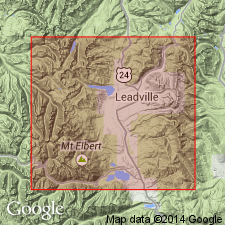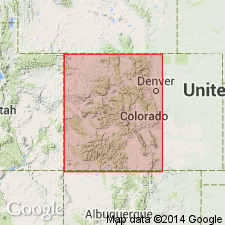
- Usage in publication:
-
- Weber shales
- Modifications:
-
- Original reference
- AAPG geologic province:
-
- Eagle basin
Summary:
Pg. 215-230, 1883 (USGS Leadville Atlas), and 1886 (USGS Mon. 12). [A name applied, on questionable correlation with Weber quartzite of Utah, to 300 feet of thin-bedded black bituminous shale underlying so-called "Weber grits" and overlying "Blue" (Leadville) limestone. Age is Pennsylvanian.]
Source: US geologic names lexicon (USGS Bull. 896, p. 2294).

- Usage in publication:
-
- Weber shales†
- Modifications:
-
- Abandoned
- AAPG geologic province:
-
- Eagle basin
- Piceance basin
Summary:
Weber should be abandoned in Colorado. Correctness of correlation of shales and grits in [Leadville and neighboring regions of] Colorado with Weber quartzite (the type formation) of Wasatch Mountains, Utah, is very doubtful.
Source: US geologic names lexicon (USGS Bull. 896, p. 2294).
For more information, please contact Nancy Stamm, Geologic Names Committee Secretary.
Asterisk (*) indicates published by U.S. Geological Survey authors.
"No current usage" (†) implies that a name has been abandoned or has fallen into disuse. Former usage and, if known, replacement name given in parentheses ( ).
Slash (/) indicates name conflicts with nomenclatural guidelines (CSN, 1933; ACSN, 1961, 1970; NACSN, 1983, 2005, 2021). May be explained within brackets ([ ]).

